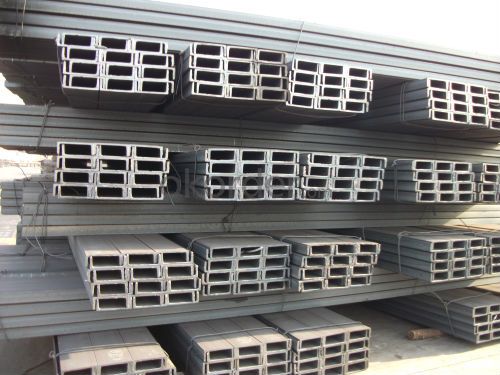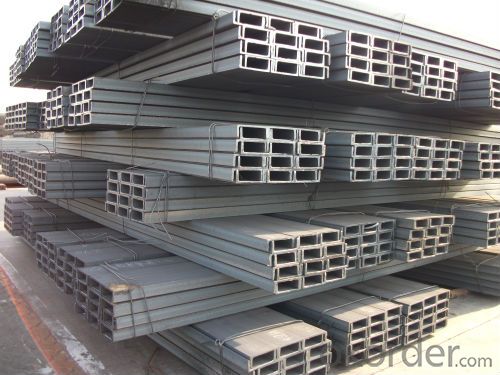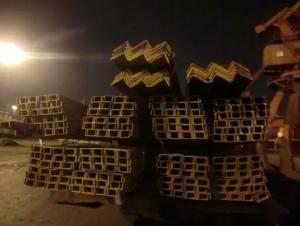JIS U- channel GB U-channel
- Loading Port:
- China Main Port
- Payment Terms:
- TT or LC
- Min Order Qty:
- -
- Supply Capability:
- -
OKorder Service Pledge
OKorder Financial Service
You Might Also Like
Product Description:
OKorder is offering U-channel at great prices with worldwide shipping. Our supplier is a world-class manufacturer of steel, with our products utilized the world over. OKorder annually supplies products to European, North American and Asian markets. We provide quotations within 24 hours of receiving an inquiry and guarantee competitive prices.
Product Applications:
1.The JIS channel can be devided into two kinds, namely common channel steel and light channel steel. The sizes of hot rolled common channel steel range from 5# to 40#. Meanwhile, the channel steel can be divided into cold forming sectional equal channel steel, cold forming sectional unequal channel steel, cold forming inner edge channel steel and outer edge channel steel.
2.The JIS channel is usually used for arch-itechtural structure, and they could be welded in order to support or hang a vari-ety of facilities. They are also usually used in combination with I beam. The channel steel with sizes under 14# is usually applied to construction engineering, as purline, while the channel steel with sizes above 16# is more likely to be used in building vehicle chassis structure and mechanical structure. Furthermore, the channel steel in sizes above 30# are target at building bridge structure, as tension bar.
3.In a word, the channel steel must possess perfect welding property, riveting property and mechanical property and so on.
.
Product Advantages:
OKorder's U-channel are durable, strong, and resist corrosion.
Main Product Features:
· Premium quality
· Prompt delivery & seaworthy packing (30 days after receiving deposit)
· Corrosion resistance
· Can be recycled and reused
· Mill test certification
· Professional Service
· Competitive pricing
Product Specifications:
1. We are definitely speciallizing in manufacturing and supplying channel steel as per japanese standard, which is characterised with high mechanical strength and competitive prices.
2. The sections in details are as followings in the table-1
JIS CHANNEL | Standard h | Sectional b | Dimension s | t | Mass: Kg/m |
| (mm) | (mm) | (mm) | (mm) |
|
50x25 | 50 | 25 | 3.0 | 6.00 | 2.37 |
75X40 | 75 | 40 | 3.8 | 7.00 | 5.30 |
75X40 | 75 | 40 | 4.0 | 7.00 | 5.60 |
75X40 | 75 | 40 | 4.5 | 7.00 | 5.85 |
75X40 | 75 | 40 | 5.0 | 7.00 | 6.92 |
|
|
|
|
|
|
100X50 | 100 | 50 | 3.8 | 6.00 | 7.30 |
100X50 | 100 | 50 | 4.2 | 6.00 | 8.03 |
100X50 | 100 | 50 | 4.5 | 7.50 | 8.97 |
100X50 | 100 | 50 | 5.0 | 7.50 | 9.36 |
|
|
|
|
|
|
125X65 | 125 | 65 | 5.2 | 6.80 | 11.66 |
125X65 | 125 | 65 | 5.3 | 6.80 | 12.17 |
125X65 | 125 | 65 | 5.5 | 8.00 | 12.91 |
125X65 | 125 | 65 | 6.0 | 8.00 | 13.40 |
|
|
|
|
|
|
150x75 | 150 | 75 | 5.5 | 7.30 | 14.66 |
150x75 | 150 | 75 | 5.7 | 10.00 | 16.71 |
150x75 | 150 | 75 | 6.0 | 10.00 | 17.90 |
150x75 | 150 | 75 | 6.5 | 10.00 | 18.60 |
150x75 | 150 | 75 | 6.5 | 10.00 | 24.00 |
|
|
|
|
|
|
200X80 | 200 | 80 | 7.5 | 11.00 | 24.60 |
FAQ:
Q1: Why buy Materials & Equipment from OKorder.com?
A1: All products offered byOKorder.com are carefully selected from China's most reliable manufacturing enterprises. Through its ISO certifications, OKorder.com adheres to the highest standards and a commitment to supply chain safety and customer satisfaction.
Q2: How do we guarantee the quality of our products?
A2: We have established an advanced quality management system which conducts strict quality tests at every step, from raw materials to the final product. At the same time, we provide extensive follow-up service assurances as required.
Q3: How soon can we receive the product after purchase?
A3: Within three days of placing an order, we will begin production. The specific shipping date is dependent upon international and government factors, but is typically 7 to 10 workdays.
Images:


- Q:Can steel channels be used for retaining walls?
- Retaining walls can indeed utilize steel channels. These channels bring numerous benefits to the table, such as their impressive strength, durability, and resistance against corrosion. They can withstand substantial weights and can be tailored effortlessly to meet specific design criteria. Moreover, steel channels offer a durable solution for retaining walls, fitting various applications like commercial, industrial, and residential projects. Nevertheless, it is crucial to take into account factors like soil conditions, drainage, and engineering prerequisites when selecting and designing a steel channel retaining wall to guarantee its effectiveness and stability.
- Q:What are the different types of loads that steel channels can bear?
- Steel channels are versatile structural components that can bear various types of loads. The different types of loads that steel channels can bear include: 1. Compression Load: Steel channels have a high load-bearing capacity and can withstand compression forces. They are commonly used in columns and beams to support the weight of a structure or transfer loads vertically. 2. Tension Load: Steel channels are also capable of bearing tension loads. They can resist forces that tend to pull or stretch the material, making them suitable for applications such as trusses or suspension systems. 3. Shear Load: Steel channels can withstand shear forces, which occur when two forces act parallel to each other but in opposite directions. They are commonly used in structural systems to resist the shearing effects of horizontal loads, such as wind or seismic forces. 4. Bending Load: Steel channels can bear bending loads, which occur when a force is applied perpendicular to the axis of the channel. They are often used as beams or lintels to support loads over openings like doors or windows. 5. Axial Load: Steel channels are designed to bear axial loads, which act along the longitudinal axis of the channel. These loads can be compressive or tensile and are typically encountered in columns or vertical members. 6. Lateral Load: Steel channels can also bear lateral loads, which act perpendicular to the longitudinal axis of the channel. These loads can arise from wind, earthquakes, or other horizontal forces and are resisted by the structural system where the channel is incorporated. Overall, steel channels are a versatile choice for structural applications due to their ability to bear various types of loads. Their strength, durability, and flexibility make them suitable for a wide range of construction and engineering projects.
- Q:Can steel channels be used in the chemical industry?
- Yes, steel channels can be used in the chemical industry. Steel channels are commonly used in various industries, including the chemical industry, due to their strength, durability, and resistance to corrosion. They are often used for structural support, as well as for the construction of platforms, walkways, and equipment supports in chemical plants. Additionally, steel channels can withstand high temperatures and pressures, making them suitable for applications where chemicals are processed or transported. Overall, steel channels are a versatile and reliable choice for the chemical industry.
- Q:Are steel channels suitable for solar panel installations?
- Solar panel installations can indeed make use of steel channels. These channels, also referred to as steel C-channels or U-channels, are widely utilized as mounting structures for solar panels. They provide a robust and long-lasting support system that guarantees the stability and durability of the panels. The reason why steel channels are preferred for solar panel installations lies in their high strength-to-weight ratio. This characteristic enables them to endure diverse environmental conditions. They also possess outstanding resistance to corrosion, a crucial factor for outdoor installations that are exposed to rain, snow, and humidity. Furthermore, steel channels can be customized and fabricated to fit specific solar panel dimensions, which allows for easy and secure attachment. Another advantage of steel channels is their cost-effectiveness compared to other mounting options, such as aluminum or stainless steel. They are readily available in the market and can be conveniently installed by professionals. Additionally, the versatility of steel channels makes them suitable for both ground-mounted and rooftop solar panel installations. To sum it up, steel channels are a trustworthy and appropriate choice for solar panel installations. Their strength, durability, resistance to corrosion, cost-effectiveness, and ease of installation make them an ideal option for providing support to solar panels and ensuring their optimal performance.
- Q:What are the guidelines for steel channel installations in corrosive environments?
- When installing steel channels in corrosive environments, it is important to follow specific guidelines to ensure the longevity and durability of the steel. Here are some guidelines to consider: 1. Material Selection: Choose a steel channel material that is specifically designed for use in corrosive environments. Stainless steel or galvanized steel are often recommended due to their resistance to corrosion. 2. Protective Coatings: Apply appropriate protective coatings to the steel channel to prevent corrosion. This can include anti-corrosion paints, epoxy coatings, or zinc-rich coatings. The coating should provide a barrier between the steel and the corrosive environment. 3. Proper Ventilation: Adequate ventilation is crucial in corrosive environments to minimize the accumulation of corrosive gases or chemicals. Ensure that the installation allows for proper airflow and ventilation to prevent the buildup of corrosive elements. 4. Regular Maintenance: Regularly inspect and maintain the steel channel installation to identify any signs of corrosion or damage. Promptly address any issues by cleaning, repairing, or replacing affected sections to prevent further corrosion. 5. Avoid Contact with Dissimilar Metals: Avoid direct contact between the steel channel and dissimilar metals, as this can create galvanic corrosion. Use insulating materials or proper coatings to separate different metals if they must be in close proximity. 6. Drainage: Ensure proper drainage of any liquid or moisture that may come into contact with the steel channel. Standing water or moisture can accelerate corrosion, so design the installation to allow for effective drainage. 7. Professional Consultation: Consult with professionals or corrosion engineers who have expertise in dealing with corrosive environments. They can provide specific guidance based on the unique conditions of the environment and recommend appropriate measures to protect the steel channel. Following these guidelines can help minimize the risk of corrosion in steel channel installations in corrosive environments, ensuring their long-term performance and integrity.
- Q:How long can steel channels last?
- The longevity of steel channels depends on various factors, including the quality of the steel, environmental conditions, and maintenance efforts. Generally, steel channels are renowned for their durability and long lifespan. They have the ability to withstand corrosion, a primary factor that deteriorates steel structures over time. Additionally, steel channels possess the capability to bear heavy loads and impacts, making them suitable for a wide range of applications. By properly caring for and maintaining steel channels, they can endure for several decades or even centuries. Regular inspections, cleaning, and addressing any signs of damage or corrosion can significantly extend their lifespan. However, it is important to note that certain factors like exposure to harsh chemicals, extreme temperatures, or high humidity levels can hasten the deterioration of steel channels. In such conditions, it is crucial to implement additional protective measures, such as coatings or galvanization, to further enhance their durability. In conclusion, the specific lifespan of steel channels cannot be determined, but their inherent strength and resistance to corrosion make them a reliable and long-lasting construction material. Through proper care and consideration of environmental conditions, steel channels can provide structural support and fulfill their intended purpose for many years.
- Q:How do steel channels contribute to the overall ventilation of a building?
- Steel channels can contribute to the overall ventilation of a building in several ways. Firstly, steel channels can be used as air ducts for the distribution of fresh air throughout the building. These channels can be strategically placed to allow for the efficient flow of air from the ventilation system to various spaces. By using steel channels, the air can be directed to specific areas, ensuring that all parts of the building receive adequate ventilation. Additionally, steel channels can be utilized as part of a natural ventilation system. Natural ventilation relies on the principles of pressure differentials and air movement to provide fresh air and remove stale air. Steel channels can be integrated into the building's design to facilitate the natural flow of air. For example, they can be placed near openings such as windows or vents to allow for the entry of fresh air and the exit of stale air. This helps to enhance the overall ventilation of the building without relying solely on mechanical systems. Moreover, steel channels can also be used for the installation of various ventilation components such as grilles, diffusers, and dampers. These components help to control the airflow within the building, ensuring that it is properly distributed and regulated. Steel channels provide a sturdy and reliable support system for these ventilation components, allowing for their effective operation. Overall, steel channels play a crucial role in the overall ventilation of a building. They facilitate the distribution of fresh air, enable natural ventilation, and provide support for ventilation components. By incorporating steel channels into the building's design and ventilation system, optimal air quality and comfort can be achieved for the occupants.
- Q:What are the different types of steel channel profiles?
- There are several different types of steel channel profiles, including C channels, U channels, hat channels, and Z channels. Each profile has its own unique shape and is used for specific applications in construction and manufacturing industries.
- Q:The types of channel steels are 6, 8, 10, 12, 16, 20, 25, 32 and 14. What are their tensile strength of these types of channel steel?
- Tensile strength and yield strength are independent of size and size, but only material.
- Q:How do steel channels perform under vibration?
- Steel channels generally perform well under vibration due to their high stiffness and strength properties. They have the ability to resist and dampen vibrations, making them suitable for various applications where stability and durability are required. The inherent rigidity of steel channels helps minimize unwanted movement and maintain structural integrity, ensuring reliable performance even in high-vibration environments.
1. Manufacturer Overview |
|
|---|---|
| Location | |
| Year Established | |
| Annual Output Value | |
| Main Markets | |
| Company Certifications | |
2. Manufacturer Certificates |
|
|---|---|
| a) Certification Name | |
| Range | |
| Reference | |
| Validity Period | |
3. Manufacturer Capability |
|
|---|---|
| a)Trade Capacity | |
| Nearest Port | |
| Export Percentage | |
| No.of Employees in Trade Department | |
| Language Spoken: | |
| b)Factory Information | |
| Factory Size: | |
| No. of Production Lines | |
| Contract Manufacturing | |
| Product Price Range | |
Send your message to us
JIS U- channel GB U-channel
- Loading Port:
- China Main Port
- Payment Terms:
- TT or LC
- Min Order Qty:
- -
- Supply Capability:
- -
OKorder Service Pledge
OKorder Financial Service
Similar products
New products
Hot products
Related keywords




























